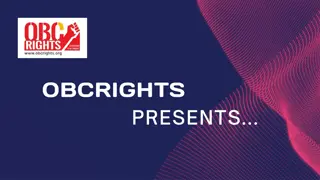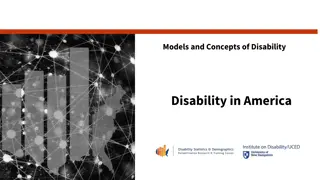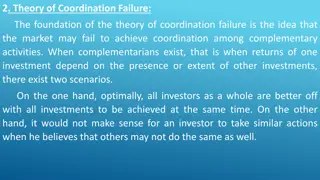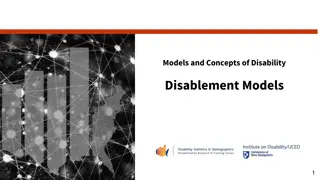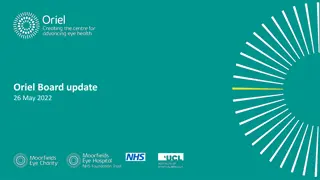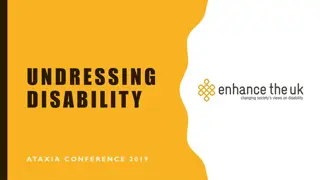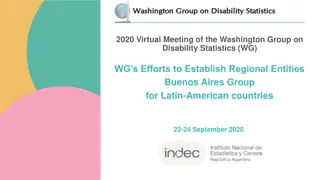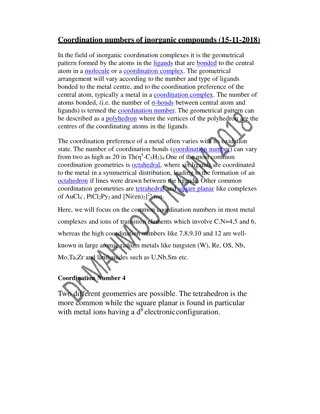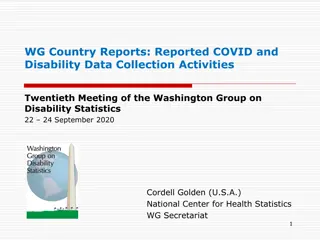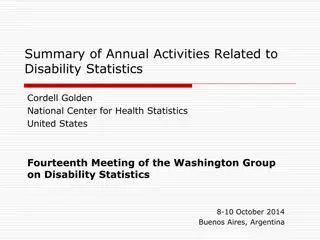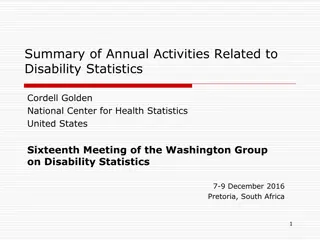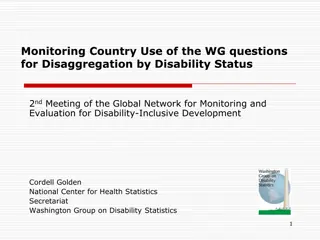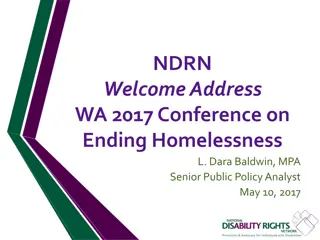Understanding the National Disability Coordination Officer (NDCO) Programme
The National Disability Coordination Officer (NDCO) Programme aims to improve education and employment outcomes for individuals with disabilities across Australia. It operates through 31 service regions, providing information, coordination, and referral services for post-school education and training. The programme focuses on enhancing transitions, increasing participation in education and employment, and establishing connections among various stakeholders to support people with disabilities effectively.
Download Presentation

Please find below an Image/Link to download the presentation.
The content on the website is provided AS IS for your information and personal use only. It may not be sold, licensed, or shared on other websites without obtaining consent from the author. Download presentation by click this link. If you encounter any issues during the download, it is possible that the publisher has removed the file from their server.
E N D
Presentation Transcript
DEAI Extra Ordinary Meeting 26thAugust 2015 Laynie Dunne-Heynis 2014 Flinders University Graduate National Disability Coordination Officer Programme
Outline What is the NDCO Programme Diamond House Clubhouse - Research and Findings Questions
What is the NDCO Programme? A network of 31service regions across Australia that provides information, coordination and referral services for people with a disability who are looking for (or are enrolled in) post-school education and training. SA has 3 NDCO Regions Region 23 : Adelaide (Western, Eastern and Southern suburbs) Region 24 : Adelaide North, Mt Lofty Ranges, Fleurieu, Kangaroo Island, Murray Mallee, South East Region 25: Pt. Lincoln, West Coast, Iron Triangle, Flinders Ranges, Far North, Yorke, Lower North, Riverland, Barossa
Why are we here? Why are we here? To work in partnership to improve education and employment outcomes for people with a disability across Australia. PATHWAYS LINKS INFORM LEGISLATION EMPOWER CAPACITY BUILDING ADVOCACY SUPPORT
Goals of the NDCO Program Improve transitions for people with a disability from their school or community into post-school education, training and subsequent employment Increase participation by people with a disability in higher education, vocational education and training and employment Establish better links between schools, universities, TAFEs, training providers and disability service providers so that they can work together to provide the best possible assistance for people with a disability.
How does the NDCO program operate? Assisting local education providers to better support people with a disability Providing information to people with a disability Linking individuals and organisations to local support services Raising awareness amongst education providers, the employment sector and the general public of the issues facing people with a disability
What services does an NDCO provide? Information, advice, coordination and referral for: people with a disability, their families and carers service providers education & training providers
Metropolitan Adelaide: Adelaide, Adelaide West, Adelaide East, Adelaide South Jennifer Cousins Tafe SA (Adelaide City Campus) Phone: (08) 8207 8652 Email: jennifer.cousins@tafesa.edu.au South Eastern South Australia: Northern Adelaide, Mt Lofty Ranges, Fleurieu, Kangaroo Island, Murray Mallee, South East Laynie Dunne-Heynis University of South Australia (Mawson Lakes Campus) Phone: (08) 8302 5444 Email: laynie.dunne-heynis@unisa.edu.au Western, Central & Northern South Australia: West Coast, Eyre Peninsula, Upper Spencer Gulf, Flinders Ranges, Far North, Yorke Peninsula, Lower North, Mid-North, Barossa and Riverland Vicki Parsloe University of South Australia (Whyalla Campus) Phone: (08) 8647 8166 Email: vicki.parsloe@unisa.edu.au NEW WEBSITE: http://www.ndcosa.com.au/
Diamond House Clubhouse Research
Aim To explore both member and professional staff experiences and perspectives of a psychosocial rehabilitation program 10
What do we know? - There can be a greater disadvantage for people who live with a mental illness when seeking employment (Dempsey & Nankervis, 2006; Wilton, 2006; Spirito-Dalgin & Bellini, 2008). - Contributing factors include negative attitudes and poor knowledge and awareness of mental illness by employers and communities (Spirito-Dalgin & Gilbride 2003). - Employment providers and vocational rehabilitation models are often utilised as specialised supports to assist people with mental illness to manage their condition and find employment (Wilton, 2006; Spirito-Dalgin & Bellini, 2008). 11
Significance There are few studies and little research involving people with mental illness within the psychosocial, return to work context (Boll, 1995). Lack of research to evaluate the Clubhouse approach within Australia and in particular South Australia. This study is further distinguished by its focus on the lived experiences of people who participate in the Clubhouse model. 12
Background This study was specific to Diamond House Clubhouse (DHC) South Australia, which provides unique person-centred, psychosocial rehabilitation and vocational support to people living with serious mental illnesses. DHC also offer advocacy, support, information for families and independent and life skills training. Developed in 1996, it is the only one of it s kind in SA, 1 of 9 Clubhouses in Australia and over 330 Clubhouses across 33 countries. The original Clubhouse was developed in New York City in 1948 as a support system for people living with mental illness. 13
Background cont.. Research focused on member and professional perspectives of the Clubhouse model. As the underpinning focus was employment, Community Bridging Services were included. While there was an employment focus, research also investigated challenges and strengths that impacted professional practice.
Participants and Recruitment Members were employed or looking for employment and connected with Diamond House. All participants were over the age of 18 years. n=6 were DHC members. All were males ranged from 33-60 years. Median age was approximately 45 years. n=5 were professional vocational workers. 15
1. perspective in terms of their psychosocial health? What aspects of Diamond House are important from the members Belonging and Positive Contributions Yeah I probably would have been dead actually .otherwise I would stay home, look at the four walls, you know, seven days a week. Since my second stroke I guess I ve gone downhill a lot, after my second stroke, so yeah I probably would have committed suicide; I was thinking about it once. (Tom, Member) Social Connectedness, Supports and Networks - One of the strongest themes to emerge from the data and underpinned positive experiences. - The ideas of support, companionship and acceptance were discussed in different ways across all interviews. - Peer to peer support was an important aspect in the recovery journey, mental wellness and community reintegration.
DHC Perceptions and Employment Impact Wellbeing and Recovery Self-esteem and Image Independence and Stability Members perceptions of Positive Characteristics Yeah brings back stability. It s been good financially, a bit of extra money; that s been very helpful. Keeping my mind active, keeping busy, getting back involved a bit with the community a bit, meeting people. (Paul, Member) I m now the person that I ve always wanted to be through my whole (life) It s taken a lot of years, a lot of learning but, you know what, it s Diamond House. It s totally changed my life, totally, and for me to explain really what Diamond House means to me, it s my world now and that s how I want it to be so I would never turn my back; never, ever. I can t see myself anywhere else and that s honest. (Doug, Member)
2. How does the member see that Diamond House has assisted them to develop skills to maintain employment? Opportunities Paid Employment and the Work Ordered Day - Empowerment in selecting daily roles - Increased self-worth - Development of work and personal skills - WOD allowed members to develop a sense of self as a worker I think it was good just to have a purpose to come here at nine o clock and do the day, have your lunch and get used to that sort of the work life again. I mean I d worked previously but with the mental illness everything went downhill so you ve got to rebuild again . (Kurt, Member)
Skills Building It s given me more confidence to operate the machines and serve; it s good. Just life skills in general; it s good. It s just a work ordered day. People volunteer to do jobs, work in the kitchen, work in the cafe. They can go out and garden whenever they want (Stinger, Member) Staff Contributions to Quality Programs Staff positive attitudes Positive qualities I think I ve been treated with a lot of respect and dignity here from the people in Diamond Clubhouse, the staff . [Name s] been a great help, you know, he s sat me down and treated me like an individual and a decent human being and given me this opportunity of work and everything. (Paul, Member)
3. The approach Diamond House takes to increase employment opportunities. Partnerships Disability Employment Services Negative Experiences - - - Felt some providers could be pushy Members recounted stories of not being taken seriously Other negative statements were directed at quality of services, poor vocational support and poor individual or person-centered support They (DES 1) probably didn t do really the best they could but yet again luckily the female staff that worked here got on and gave them a phone call and gave them a kick because they were trying to get out of funding and stuff, paying for things, courses She was like she knew because when you feel down there you re not wanting to stand up for yourself. You know it s not right, what they re doing, but... what can you do? (Kurt, Member)
Positive Experiences Underpinned by person centred principles including acts of listening and following up. Members felt as though they were taken seriously. Fortnightly or weekly meetings were productive even in the absence of employment opportunities. When they were looking around for different jobs for me they actually asked me what I wanted to do so basically they got my feedback of what I wanted to do and what I m after and they work around that for me so it makes it easy They ve actually gone out of their way to help people get work and they ve actually succeeded on that and it makes them feel better as well because they ve got a client in the workforce so that s a rising star for them. (Fred, Member)
4. Staff and Professional Practice Challenges Resources and Funding - Staff shortages - Increased caseload - Need for equipment upgrades Contractual and Business Obligations - Star ratings versus a person centred environment Job Readiness - Member versus Professional perceptions I think one of our fears is that some of these bigger organisations who are running the employment agencies don t work from a person centred base and that they are driven by the dollar and that they are driven by the outcomes. This is why I think it s not as successful as it should be or it could be and that we need to work together to support the NGO sector and the employment sector to find employment outcomes and to help people stay in these jobs, not just for the money but for their wellbeing. They won t last otherwise; they don t. (Karen, Professional Staff)
Attitudes Perceptions and Stigma: Community and Employment Employer and Community Mental Health Knowledge - Difficulty finding empathetic employers - Negative perceptions of mental health - Wide examples of stigma and discrimination - Disclosure Strengths Recovery and Wellbeing Standards and Operation it s the social connection, it s the motivation, it s feeling good that I m a valued member of a community. I m putting in and I m a part of something I haven t been for a long time ; for many it s been ten years or more. (Karen, Professional Staff)
Limitations As the research is specific to the DHC context, findings cannot be generalised across other settings and contexts. Bias or specific emphasis may have occurred as a result of gender imbalance of members who participated. Another limitation is that this study only focuses on the experiences of members who are active . Alternatively, active members may experience participant bias as a result of their involvement with the Clubhouse and less active members are so because they are not satisfied with the services.
Directions for Future Research This research presents an important first step in attempting to provide insight into DHC and their model of psychosocial support. Comparative research across other CHs and employment approaches could also be useful in assisting with the sharing of information across the sectors of disability, mental health and employment, regarding partnerships and strategies. Quantitative research could also be useful in providing further data about linkages and an analysis of statistics which could also be useful in determining how information is disseminated within networks.
Implications for Policy and Practice, Recommendations and Summary Based on cost comparisons to other programs and vocational successes, it is recommended that additional research be undertaken to explore the usefulness and effectiveness of the Clubhouse model as a vocational intervention. In partnering with the DES Community Bridging Services, Diamond House is challenging the communication barriers regularly seen between service providers and providing continuity of service provision for members. Another implication arises from the perceived view towards, and seeming lack of awareness of the CH model within the community, including among members themselves. Gaining ICCD accreditation may facilitate this recognition of Diamond House in the mental health field and amongst community members.
Continued This research, corroborated by the literature, also highlights the complex nature of DESs overall and how contractual obligations directly impact their requirements and capacity to provide person-centred support (Waghorn, 2013; King et al., 2006; Rogers, 2007). An area of concern is the continual feedback provided to DES program administrators, particularly with respect to the restrictive nature of star ratings; however it appears there has been little progress over time (Waghorn, 2013).
Questions? 29







